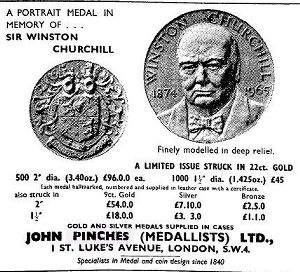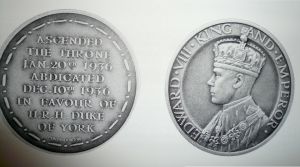The Clapham Society Local History Series — 19
Pressing Time in the history of the Commemorative Medal
by Alyson Wilson
This article first appeared in the South London Press on 10 March 2017

In 1836 young John Pinches, who had trained with his father as a silversmith, which included replating and engraving, moved from his native Birmingham to London. He soon made a friend of William Wyon, and joined him at the long established firm of medallists and sculptors where he worked. Pinches and Wyon then set up on their own and one of their early successes was Queen Victoria’s Coronation Medal designed by Wyon and minted by John Pinches. Another popular medal they made was the souvenir medal for the Crystal Palace exhibition at Sydenham in 1854, which showed Queen Victoria in the Imperial Crown with Prince Albert on one side, and Britannia and female figures of Commerce and Industry on the reverse. The large medal was made in silver or bronze to be awarded as a prize, or smaller and in white metal as a souvenir. A medal which showed a more familiar picture of Queen Victoria was minted to celebrate her 80th birthday in 1897.
The business was established in the West End at first, but as it grew it moved to custom built premises on Albert Embankment, almost opposite the Tate Gallery in the early 20th century. Here John R Pinches, son of the founder of the business was in charge of the business. Many First World War medals were minted here. Other medals celebrated sportsmen, societies and events, ranging from the Cyclists’ Touring Club to the Institute of Physics and the Metropolitan Amateur Regatta. Sadly many of the company records were lost in the disastrous River Thames flooding of 1928.
In 1935 John Pinches decided to move the company further out of London and bought property in Clapham with a view to expansion. This proved to be particularly fortunate because the Albert Embankment building was completely destroyed by bombing during World War II. Pinches’ new base was the former chapel of Clapham Grammar School and the Surrey Conservatoire of Music on the corner of Clapham High Street and St Luke’s Avenue – the site is now occupied by Cactus TV. Clapham Grammar School was closed in 1881, to be demolished soon after, but the chapel was bought by the Surrey Conservatoire of Music who built an attractive red-brick villa in St Luke’s Avenue and used the adjoining chapel as their concert hall. After the closure of the Conservatoire the Clapham Reform Club was based here until John Pinches bought the site to adapt and extend the buildings for his factory in 1935. At that time the chapel’s stained glass windows survived. An advertisement placed by John Pinches in The Times in October 1935 offered for sale ‘15 stained glass windows’. There were no takers, so the windows had to go into store.

An interesting medal made in 1936 commemorates the accession to the throne in January of King Edward VIII and his abdication in December that year. Pinches Medallists survived World War II well, and alongside production of medals which included French Croix de Guerre and Cross of Lorraine medals, machinery was adapted to produce parts for weapons for the Ministry of Supply, as the company had done before during World War I.
The business flourished after the war: new up-to-date machinery was installed in 1958 and, it is recorded, that at that time the company employed 120 people. The Clapham Society has been contacted by several people who worked there at that time. A recent 81-year old correspondent, whose family lived just off the High Street, told us that he and his two sisters had all worked at Pinches Medallists. A local historian wrote about visiting the works in 1953 when they were producing the Queen Elizabeth II Coronation medal. Other notable medals produced in the Clapham years included the 1948 Olympics medal and a Winston Churchill memorial medal minted after his death in 1965.
Unfortunately the story did not end happily. By the late 1960s the third John Pinches and his cousin, Leslie, were running the company but there were no family members to succeed them. Thinking an overseas connection would be advantageous for the company, in 1969 they sold out to Franklin Mint of Pennsylvania, which had been founded by Joseph Segal in 1964. All too predictably the Clapham works, then the entire UK operation were closed down. Franklin Mint changed hands several times and ceased to produce the fine, crafted medals for which Pinches had built a reputation over 130 years.